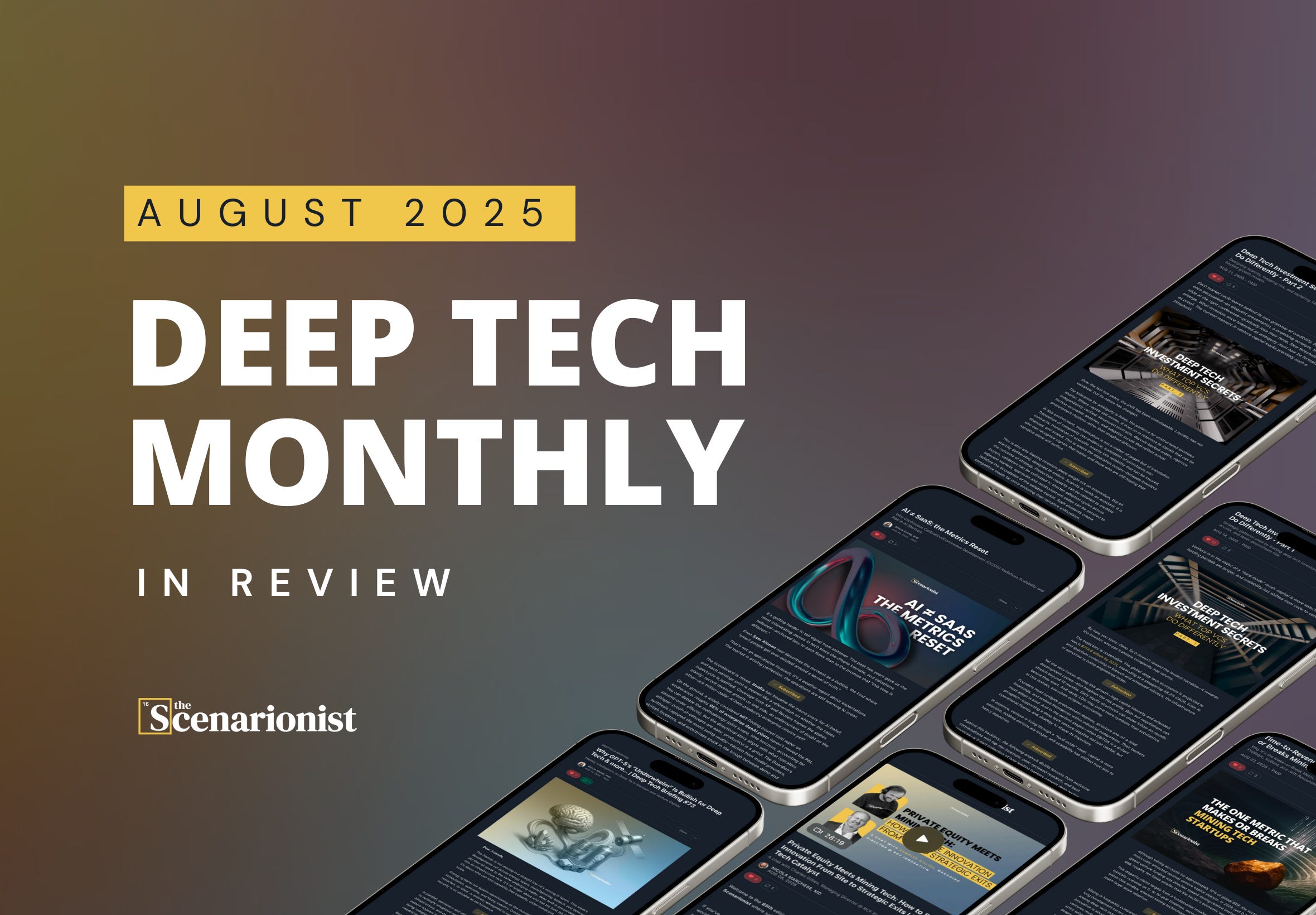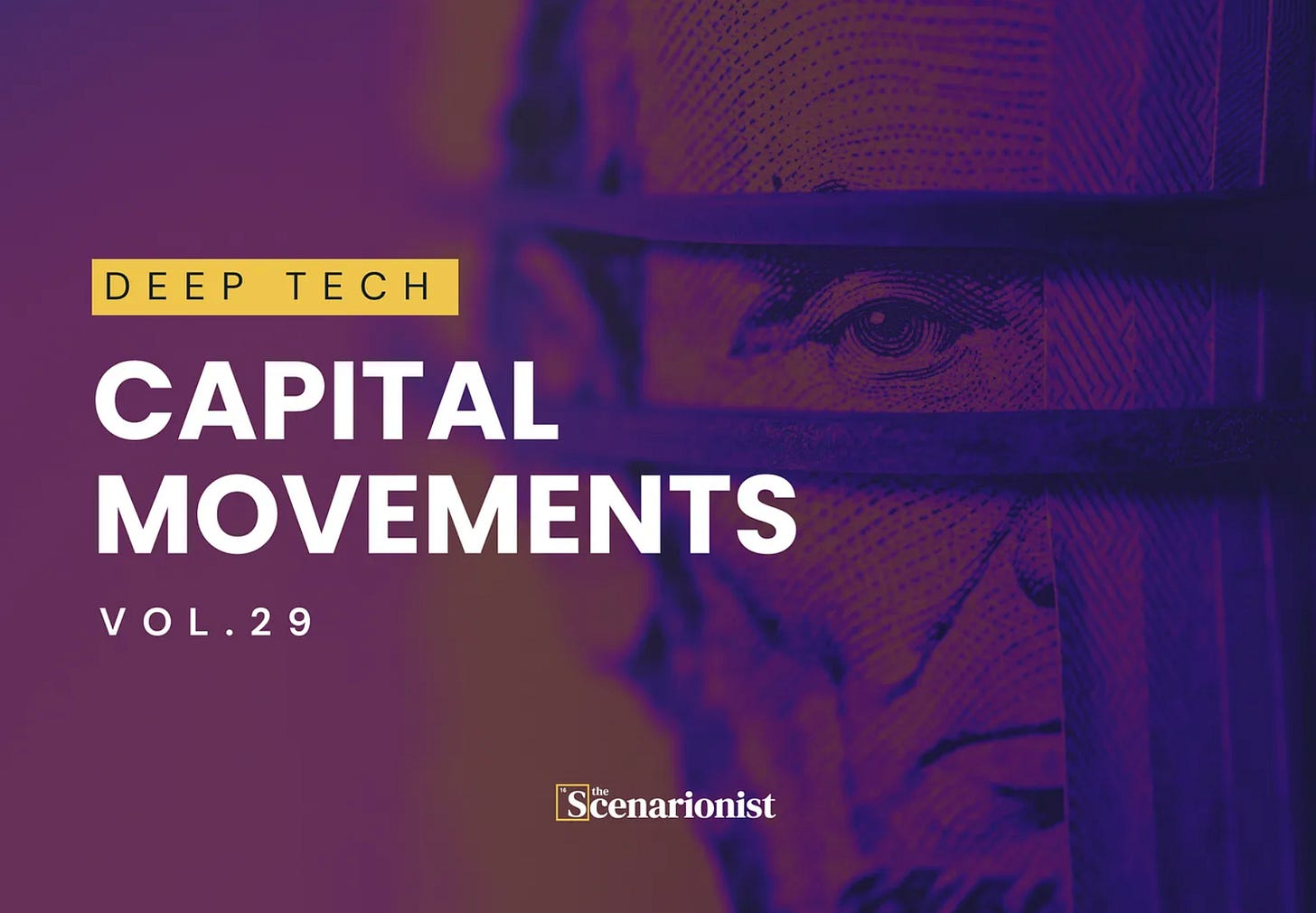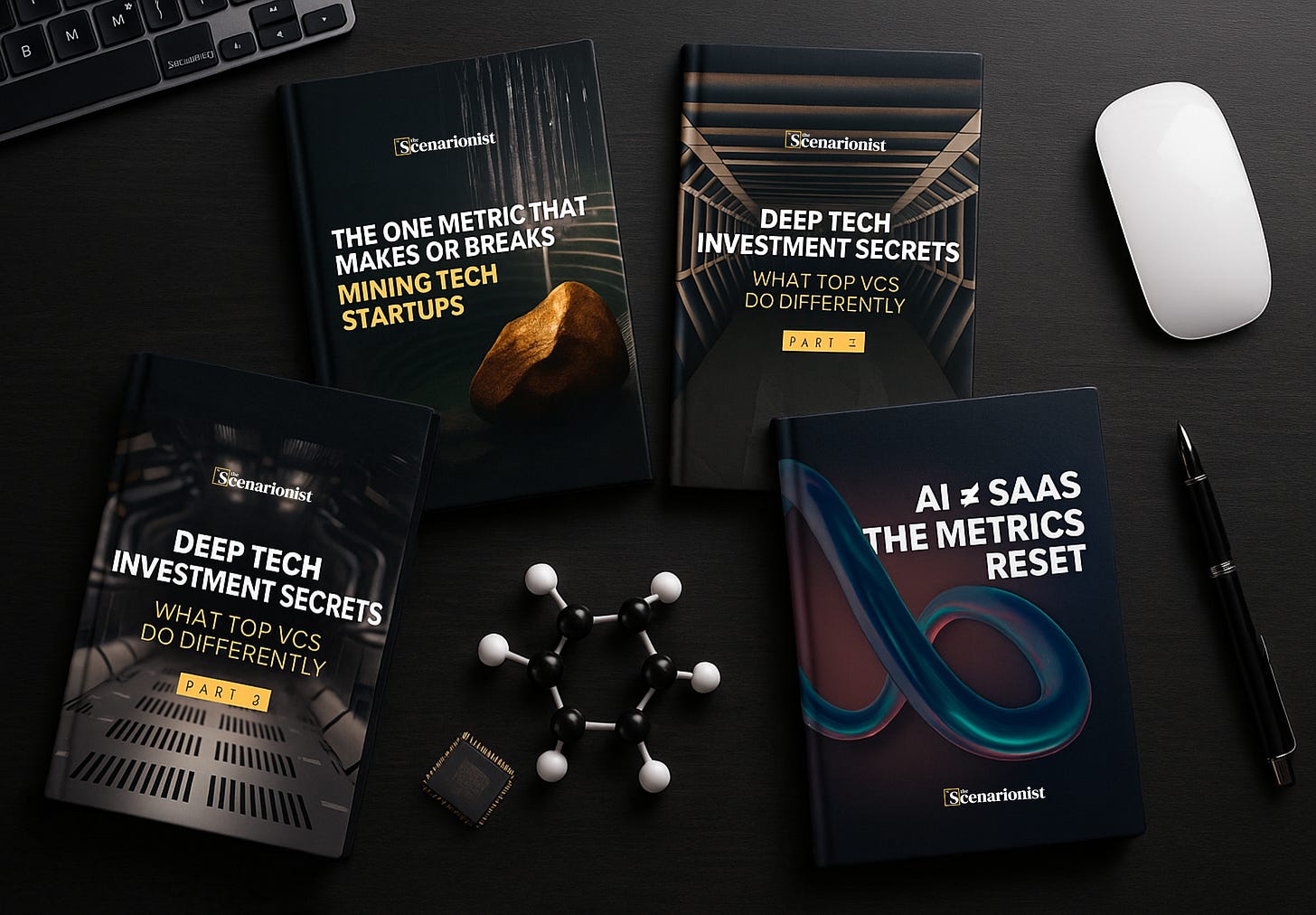Deep Tech Monthly in Review – August 2025
Field Notes from The Scenarionist. A Strategic Recap for Builders and Backers
Dear Builders and Backers,
Benjamin Graham opened Security Analysis with a simple provocation: price is what you pay; value is what you get.
August made that maxim feel less like a Wall Street aphorism and more like a factory-floor audit.
In deep tech, “value” has left the slide deck and moved into the substation, the cleanroom, the launch pad, the clinic. Markets are valuing what actually runs—and punishing anything that doesn’t. What financed novelty in 2021 now underwrites throughput in 2025.
Markets reward what endures.
In August, endurance meant throughput under constraint: watts close to the racks, robots judged by uptime not demos, satellites that decide before they downlink, and nuclear programs that train people before they pour concrete. The tape favored those who priced the bottlenecks instead of narrating around them.
Three linked signals ran through the portfolio of stories analyzed:
Compute became collateral. Financing shifted from “more model” to “more electrons, more availability, lower latency.” GPU capacity was underwritten like turbines; sovereigns backed siting and power; and on-prem trendlines turned into checks for rack-scale systems and non-GPU accelerators.
Autonomy consolidated around brains, not bodies. “Robot brains” with cross-form-factor SLAs took center stage; acquisitions folded perception into existing fleets; the unit of value became a guaranteed service level, not a single chassis.
Space refactored into workflows. Deep-space navigation talent and on-orbit inference moved into integrated stacks; earth-observation shifted from pixels to underwriting and compliance workflows. Defense was not a pivot—it was gravity.
August’s edition serves one purpose: a strategic snapshot of what moved and why, and a practical index to a market that priced reliability.
Firm power near load, SLA-anchored autonomy, and on-orbit inference formed the backbone. The supporting work supplies the ledger behind each pattern.
Macro Currents — The System as the Strategy
1) The Industrial AI Organism: cash, watts, latency
This stack now moves as one system. Capital concentrates at the training frontier, power availability sets the build schedule, and latency drags compute to the edge—inside robots, vehicles, and satellites.
That’s why three things showed up almost at once in August: lenders extended GPU credit to providers with proven utilization; investors backed firm power next to data centers (including nuclear tied directly to AI demand); and materials wins—denser anodes, better magnets, smarter packaging—improved compute per watt.
The playbook is straightforward: pair rack-scale deployments with reliable power at the fence line, and design inference to run where the work happens. Do that, and you shorten time-to-capacity and lower cost per token.
2) Defense-grade integration: interface, don’t replace
Enduring demand pooled where startups plug into incumbent systems instead of trying to rip them out.
Guidance, autonomy, ISR, and cyber-physical visibility sold best when they snapped into existing flight software, ground tools, and mission workflows.
On-orbit inference addressed bandwidth limits head-on; in Europe, dual-use moved from “pivot” to default. The upside is faster iteration with real requirements and real budgets.
The risk is buyer concentration. Keep optionality by hardening compliance early and structuring contracts that don’t lock you to a single program forever.
3) Structured, sovereign-tied capital
August’s financings followed a clear storyboard: use equity to retire core tech risk, grants to derisk interfaces and safety, offtakes or guarantees to make revenue bankable, and credit to pay for steel, electrons, and racks.
We saw that stack across storage, magnets, rack-scale compute, and robotics-as-infrastructure.
The result is practical freedom of motion: lower weighted average cost of capital, faster readiness, and a cleaner Series B narrative that ties every dollar to a milestone that removes real risk.
Sector Deep Dives
Compute × Power: From Models to Megawatts
Credit where cadence lives. Providers with verifiable utilization unlocked GPU credit lines; rack-scale on-prem rose as sovereignty and licensing risk sharpened. Pair compute with firm power near load—sodium that ships warm, heat-to-power blocks for AI campuses, and siting that arbitrages interconnection queues.
The new BOM: accelerators tuned for transformers/diffusion; near-/in-memory compute to kill the weights shuttle; photonic interconnects; chiplets. The goal is $/token and latency, not parameter counts.
Policy tailwinds: state manufacturing credits and federal AI sandboxes shortened procurement and capex cycles. Wire them into your financing storyboard.
Autonomy & Robotics: Uptime is the SKU
Serve acquired Vayu Robotics to fold a perception FM into last-mile ops; FieldAI’s raise validated cross-form-factor “robot brains.” Contracts are reading like availability insurance: SLAs, MTBF curves, route density, and maintenance learnings as moat. Sell outcomes.
Space & Dual-Use: Guidance + On-Orbit Inference
Intuitive Machines moved to absorb KinetX Aerospace (deep-space navigation); Voyager paired with Latent AI to run models in orbit. EO without vertical workflows struggled; defense demand provided gravity and credit. Guidance, flight dynamics, and edge ML are the revenue stack.
Hubble’s bet on Muon’s heavy-class bus for orbital BLE showed “space-as-a-service” absorbing comms plays: multi-kW power budgets, optical crosslinks, high-throughput downlink—capabilities long reserved for national security—now shipping to commercial constellations.
Materials & Manufacturing: Factories as Front-End Product
Magnets and anodes re-rated as strategic components; copper recovery and in-fab yield AI converted telemetry into financeable de-risking. Treat the pilot line as product #2: a moving data room that earns lenders’ trust while it ramps.
Bio & Medtech: Evidence, Reimbursement, Distribution
Diagnostics moved where payer logic and channel strategy came pre-wired; radiopharma and CNS re-rated on better tools and Phase II de-risking. A six-month biotech IPO drought sharpened focus on non-dilutive catalysts and procurement-led scaling.
Nuclear & Fusion: Cadence over Charisma
TerraPower broke ground on a state-of-the-art training center—arguably the most bankable milestone in advanced fission. General Fusion secured a lifeline to keep learning curves alive. Add thorium progress in Idaho and fusion program timelines in Europe: August rewarded workforce, fuel, and schedule over slogans.
Pattern Breakers: what surprised us (and why it matters)
Precision agriculture outpaced ag-biotech by 71% year over year. That’s not a triviality; it’s a signal that sensor-based technology, field-tested and with regulatory clarity, will outperform purely lab-based experiments when budgets tighten. If you belong to this category, you’re on the right side of procurement.
FOAK financing is arriving earlier than expected. Blended stacks—non-dilutive grants + milestone-tied offtake + receivables-backed working capital—are funding first units without crushing dilution. If you can show CAT-level acceptance tests and uptime SLAs, you can borrow sooner, not later.
NASA’s lunar fission timeline was pulled forward. Off-world manufacturing and energy are now planning inputs, not science fiction. If you supply the components, your TAM just gained a buyer with impeccable credit.
Founder’s checklist (pin it to your war room)
Treat capital like a storyboard. Equity for invention, non-dilutive for proof points, project debt for steel. Every dollar must correspond to a measurable reduction in risk. (Use the Capital Movements examples to justify the structure of your term sheets.)
Treat schedule engineering as a product. Permitting, EPC bandwidth, workforce training, fuel availability—these are not “operations.” They are features investors will pay a premium for. Show the dates; show your crews.
Price outcomes, not features. In autonomy, the winning SKU is uptime. In energy, it’s heat on demand. In space, it’s navigation and inference. Rewrite your pricing around the buyer’s KPIs.
Align with sovereignty on purpose. Where your roadmap intersects national capability programs, lead with accreditation and delivery cadence. This turns meetings into concrete outcomes.
Make the unit-level inflection explicit. Every milestone must move a cost curve or a reliability curve. Otherwise, it’s theater. Use our “One Metric” essay to wire this into your board rhythms.
The Investor’s Lens — Where August’s Alpha Hid
Procurement-led scaling. Teams that translate prototypes into contracts by speaking the buyer’s KPI language cleared the bar—RaaS with availability guarantees, EO workflows embedded in insurers, and magnets aligned to national capability programs.
Materials as leverage. Anodes, magnets, and packaging created earnings power not by stories but by shifting system curves (density, thermal management, yield). These are compute and autonomy enablers in disguise.
Sovereignty premia. Sovereign-aligned categories (magnets, on-orbit compute, analog design) traded at lower demand risk; offtakes and offsets helped. The reliable edge was revenue visibility married to national objectives.
Credit as multiplier. GPU facilities and infrastructure debt expanded TAM without diluting control, provided utilization and siting were locked. Structure created optionality.
Regional Read — Same Physics, Different Calendars
United States. Growth dollars congregated where electrons meet inference (GPU credit + nuclear), where autonomy is an SLA (robot brains), and where bio paired platform with near-term catalysts. Policy broadened distribution (e.g., retirement channels) and manufacturing credits.
Europe. Defense gravity anchored space; EO monetization still demanded verticalization; fusion timelines got dated coordination nodes. Growth checks flowed from U.S. capital with governance to shorten exit clocks.
APAC & Australia. Ambient-temperature hydrogen demos and sovereign compute alliances emphasized logistics-friendly deployments and regional autonomy. Seed hardware showed where prototypes cut OPEX from day one.
What we’re putting in your hands (and how to use it)
Consider The Scenarionist a second layer of signal, built for operators who turn friction into margin:
Deep Tech Briefing: weekly operating intelligence on startups, markets, and policy—intel you can forward to your board before the Monday meeting, use for strategic decisions, and keep in your pocket for breakfast meetings or stimulating fireside chats.
Deep Tech Catalyst: founder-ready implementation manuals—GTM models, LOIs, integration paths, manufacturing logic. These aren’t “views”; they’re checklists.
Capital Movements: the tape on who’s raising, who’s betting, and why—decoded into structures you can replicate.
Exclusive Insights & Analysis: deep dives that redefine tomorrow’s $100B markets, with the math that drives bankability—not the marketing that makes noise—plus operating tools and playbooks.
Appendix: What Happened, Piece by Piece
A. Deep Tech Briefing
Edition 72 — 📈 Strategic Dual-Use IPO; ⚛️ First Fusion Power to Grid; ⚡ Virtual Power Plants Scale; 🔋 First Grid-Scale Sodium-Ion Battery; 🚀 NASA Backs Supersonic Combustion
Public markets start to re-rate defense-aligned platforms while grid-tied fusion, VPP orchestration, and sodium-ion storage show pragmatic progress—signals that durable revenue is coming from deployable infrastructure, not demos.
Edition 73 — Why GPT-5’s “Underwhelm” Is Bullish for Deep Tech & more...
A softer model cycle shifted advantage to physics and supply chains: distressed gigafactories became lithium-sulfur relaunch pads, microreactors and U.S. enrichment reset nuclear cadence, GEO/LEO assets and lunar storage tested resilient comms, mRNA IP priced like infrastructure, and policy (Germany’s fusion agenda, 401(k) access to alts, EU resilience rules) widened the financing lanes for builders.
Edition 74 — Why Are US VCs Writing AI Term Sheets Far From Sand Hill Road?
Transatlantic AI capital set the tone, but the week was broader: defense and fusion milestones moved from pilot to procurement; pad scarcity, SRM capacity, and AI-campus power needs reframed execution risk; maritime risk tech and rail-battery plays showed data→revenue logic; and policy—EU security, U.S. critical-minerals, Pennsylvania’s fast-track permitting—compressed time from proof to purchase.
Edition 75 — 🤖 Frontier AI Capex; ⚡ Firm Power Near Load; 🛰️ Edge Analytics in Orbit; 🔋 Grid Batteries Energized; ⚛️ Advanced Fission Trains Up
Capital, policy, and operators converged on throughput: frontier AI funded like infrastructure, robots bought on uptime SLAs, on-orbit inference integrated into defense workflows, and firm power plus state manufacturing credits compressing the path from pilot to procurement.
B. Deep Tech Capital Movements
Vol. 29 — 💸 $11M Seed Dual-Chem Batteries; €325M Debt for EV Infra; $100M Series B Cloud Racks; $18.7M Seed Copper Recovery; $8.5M Series A In-Fab Yield AI
Hybrid finance went mainstream as debt underwrote EV infrastructure and seed checks targeted modular climate hardware; capital favored dual-use autonomy, sovereign/on-prem compute, and embedded factory AI that converts quickly to operating revenue.
Vol. 30 — 💸 $200M Growth for AI Materials; $8.8M Seed for In-Orbit Defense Vehicle; $20M Series A for Semiconductor; $6M Seed to Advance Grid-Edge Monitoring
Money clustered where AI meets atoms: compute-first materials, analog design and thermal plumbing, grid-edge monitoring, and defense-anchored space seeds—backing bottleneck killers with short time-to-revenue and project-financeable rollouts.
Vol. 31 — 💸 $65M Series A Rare-Earth Magnets; $20M Series A Analog IC Design; $1.6M Pre-Seed Autonomous Drones; €650K Pre-Seed Industrial AI & more
Investors prioritized certified capacity and factory-floor intelligence—U.S. NdFeB magnet sovereignty, analog design “digital twins,” in-fab yield vision—alongside VPPs and brownfield decarb, signaling a shift from demos to procurement-ready systems.
Vol. 32 — 💸 $405M Robot Brains; $463M EV Anodes; $275M GPU Credit; $313M Gene Therapy; $230M Corporate Security; $100M Nuclear for AI
Checks concentrated on embodied AI and energy-for-AI—platform “robot brains,” silicon-carbon anodes, GPU financing, and nuclear power for data centers—while regulated health and security telemetry drew growth rounds for solutions that remove scaling constraints and translate directly into POs.
C. Deep Tech Catalyst
Episode 84 — Forestry x Carbon Credits: Building Investable Models at the Frontier of Nature Tech (with Chloë Payne, Ponderosa Ventures ) 🌲
The real asset is trust: infrastructure, rigorous protocols, and pre-purchase agreements as a Series A signal; dual-revenue models (primary product + credits) make “venture-like” what would otherwise be project finance.
Episode 85 — Private Equity Meets Mining Tech: How to Scale Innovation From Site to Strategic Exits (with Charles Gillies, RCF Innovation) ⛏️
In mining, “innovation” > “technology”: sell outcomes, not features; map the decision-makers, defend pricing with on-site, proven ROI, and scale from $2M ARR toward an OEM exit in 3–5 years by optimizing channels, geographies, and product portfolio.
Episode 86 — What VCs Look For in Early‑Stage Diagnostics (with Tom Miller, GreyBird) 🧬
Start from the clinical problem and the decisions that change at the bedside; build a risk map (analytical → clinical → regulatory), validate in real-world chaos, and demonstrate clinical utility and reimbursement with ultra-efficient capital.
Episode 87 — AgTech From Lab to Scale: Moats, Markets, and Strategy (with Ana Ward, Yanmar Ventures) 🚜
RaaS, retrofit, and modular systems beat “full replacement”: per-use/per-acre pricing, pilots with seasonal ROI, distribution through OEMs/co-ops as a moat, and proprietary data to extend from single region–crop to global scale.
Episode 88 — Inside Limited Partners: How Deep Tech Gets Funded from the Top of the Capital Stack (with Béla Hanratty, Keeling Capital) ⚡
From asset owner to startup: GP–thesis fit as the first filter, differentiation on sourcing/selection/value creation, fund size aligned to stage, and blended-capital pathways to avoid equity dependence in asset-heavy technologies.
Throughline: measurable quality, ROI close to the field/clinic/site, and financing instruments aligned to risk turn prototypes into investable assets.
C. Insights & Analysis
Time-to-Revenue: The One Metric That Makes or Breaks Mining Tech Startups — Why It's the Make-or-Break Metric — Tactics to Accelerate It, Plus 3 Case Studies: Plotlogic, KoBold, and Jetti Resources.
Deep Tech Investment Secrets: What Top VCs Do Differently - Part 1 — Strategic patterns used by leading deep tech investors to get better deals, faster access, and lower downstream risk.
Deep Tech Investment Secrets: What Top VCs Do Differently - Part 2 — Designing scarcity, mapping risk, and replacing TAM theater with real buyer-backed growth models.
AI ≠ SaaS: the Metrics Reset. — Why Continuous Calibration/Continuous Development (CC/CD) Redefines Scalability and Risk in AI Startups.
Closing position
Benjamin Graham called it temperament; we call it discipline.
August rewarded the companies and investors who honestly priced schedule risk, matched instruments to milestones, and turned sovereign alignment into profits.
The narrative premium is gone. Good.
That’s where durable returns are made: where a factory’s telemetry becomes intellectual property, where a robot’s uptime becomes ARR, where the simplicity of a sodium system becomes cheaper debt, and where a training center is the most bankable milestone on the road to clean baseload.
If you build where electrons, atoms, and code meet—and if you value cadence over charisma—you’ll like the world August just announced.
And if you want to win in that world, take the pieces we shipped, wire them into your operating rhythm, and put them to work, so friction becomes margin and infrastructure becomes permanence.
One Last Thing: Upgrade Your Edge
The Scenarionist Premium is where we turn signal into operating leverage—weekly premium insights + tactical resources, our full Venture Playbook Library, and a searchable archive of every premium piece.
If your job is to convert science into cash flows—or to underwrite the teams that do—this is your second tier of signal. Join today!
Stay disciplined. Stay sovereign-aligned. Build for constraint.
We’ll see you in September—with more briefings, more playbooks, and more operator-grade analysis to help you convert physics into returns.
— Giulia & Nicola








